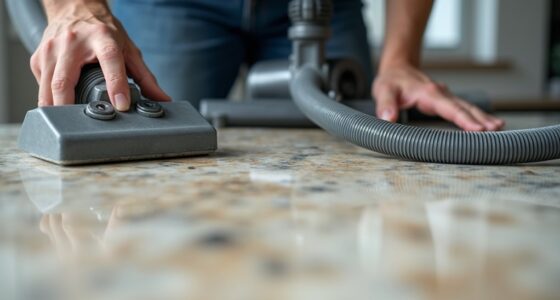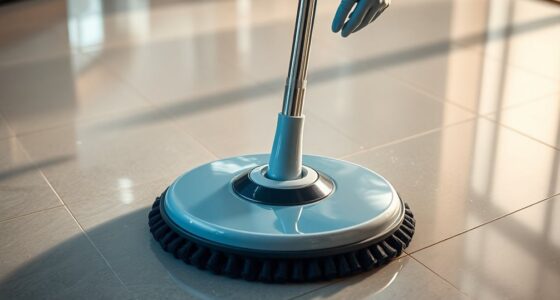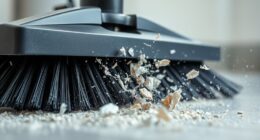Using harsh scrubbing tools or applying too much pressure can scratch or dull your epoxy floor. Avoid worn or dirty brushes and scrub with gentle or medium settings to prevent damage. Using incompatible or harsh chemicals can also weaken the surface. Always inspect your equipment before use and stick to pH-neutral cleaners. Proper techniques and tools matter—continue exploring how to keep your epoxy floor pristine and damage-free with simple, effective tips.
Key Takeaways
- Using overly aggressive scrubbing tools or high pressure can scratch or gouge the epoxy surface; fix by switching to gentle brushes and reducing pressure.
- Applying harsh or incompatible chemicals weakens the epoxy; use pH-neutral cleaners specifically designed for epoxy floors.
- Over-scrubbing or frequent deep cleaning accelerates wear; stick to routine light sweeping and occasional deep scrubbing as needed.
- Not inspecting or replacing worn equipment leads to surface damage; regularly check and maintain brushes and pads for optimal condition.
- Failing to dry the floor properly after cleaning causes streaks and potential damage; always use a clean mop or squeegee to dry thoroughly.

Cleaning epoxy floors with a scrubber can improve their appearance and longevity, but making common mistakes can cause damage or reduce their durability. One of the most important factors to consider is cleaning frequency. Scrubbing too often can wear down the epoxy coating, especially if you’re using aggressive brushes or harsh chemicals. Conversely, not cleaning enough can lead to the buildup of dirt, grease, and debris that can stain or degrade the surface over time. Striking the right balance is key. You should develop a regular cleaning schedule based on the foot traffic and type of use your floor experiences. Light sweeping or vacuuming daily helps remove loose dirt, while deeper scrubbing can be scheduled weekly or bi-weekly, depending on your needs. This approach prevents buildup without overexposing the epoxy to unnecessary wear.
Maintain a regular cleaning schedule to protect your epoxy floors from damage and staining.
Another common mistake involves neglecting equipment maintenance. Using a scrubber with worn brushes or damaged pads can scratch or gouge the epoxy surface, diminishing its smoothness and protective qualities. Always inspect your equipment before each use. Replace worn brushes, pads, or other attachments promptly to ensure effective cleaning without harming the floor. Additionally, check that your scrubber’s settings are appropriate for epoxy floors. Using excessive pressure or high-speed settings can cause surface damage, so adjust the machine to a gentle or medium setting for routine cleaning. Proper equipment maintenance not only preserves your floor but also extends the lifespan of your cleaning tools, saving you money in the long run.
Many people overlook the importance of cleaning solutions suited for epoxy floors. Using overly harsh chemicals or incompatible cleaning agents can weaken the epoxy’s finish. Always opt for pH-neutral cleaners designed for epoxy surfaces. These are effective at removing dirt and stains without stripping away the protective layer. After scrubbing, make sure to rinse thoroughly to eliminate any residue that could cause discoloration or attract more dirt.
Lastly, don’t forget that even the best cleaning routine can backfire if you neglect proper drying. Moisture left on the surface can lead to streaks, spots, or even damage over time. Use a clean, dry mop or squeegee to remove excess water, ensuring your floor dries quickly and evenly. By paying close attention to cleaning frequency, maintaining your equipment, and choosing the right cleaning products, you’ll keep your epoxy floors looking pristine and extend their lifespan. Regular upkeep combined with mindful practices can prevent costly repairs and maintain the epoxy’s aesthetic appeal for years to come.
Frequently Asked Questions
Can Using Too Much Water Damage Epoxy Floors?
Using too much water can cause water damage to epoxy floors, especially if you don’t dry the surface properly afterward. Excess moisture seeps into the seams or cracks, weakening the adhesive and causing bubbling or peeling over time. To avoid this, control your cleaning frequency and ensure you use minimal water during scrubbing. Always dry the floor thoroughly to maintain its durability and prevent long-term water damage.
Is It Safe to Use Commercial Scrubbers on Epoxy?
Yes, you can safely use commercial scrubbers on epoxy floors if you choose the right industrial equipment and cleaning chemicals. Opt for soft brushes and gentle cleaning agents to prevent damage. Be cautious with high-pressure settings and harsh chemicals, which can cause cracks or dullness. Always follow manufacturer instructions, and test a small area first. Proper use guarantees your epoxy remains pristine and protected during scrubbing sessions.
How Often Should I Deep Clean Epoxy Floors?
You should deep clean your epoxy floors every 3 to 6 months to keep them in top condition. Regular floor cleaning and maintenance tips help prevent dirt buildup and damage. Use a gentle scrubber and mild cleaning solutions to avoid scratching or dulling the surface. Consistent deep cleaning maintains the epoxy’s appearance and durability, making your floors look great and last longer. Adjust frequency based on foot traffic and usage.
Do Different Scrubber Pads Affect Epoxy Surface Longevity?
Yes, different scrubber pad types can affect epoxy longevity. Using abrasive pads like steel wool can scratch and degrade the surface over time, shortening its lifespan. Instead, opt for softer pads such as microfiber or non-abrasive scrubbers. These preserve the epoxy’s integrity while still cleaning effectively. Choosing the right scrubber pad types guarantees you maintain the epoxy surface’s durability and prolong its longevity, saving you time and money in repairs.
Can Improper Scrubbing Void Epoxy Floor Warranties?
Think of your epoxy floor as a delicate masterpiece; improper cleaning can be the chisel that damages it. Yes, improper scrubbing can void your warranty because it may cause surface damage or degrade the coating. To protect your investment, follow manufacturer guidelines and avoid harsh chemicals or aggressive scrubbing. This way, you keep your warranty intact and your floor looking flawless, like a work of art that stands the test of time.
Conclusion
So, next time you grab that scrubber, remember: it’s not a magic wand. Avoid common mistakes, don’t skip the gentle touch, and you’ll keep your epoxy looking fabulous—without turning it into abstract art. Mistakes happen, but with a little know-how, you’ll be the Picasso of floor care. Keep it simple, keep it shiny, and maybe, just maybe, resist the urge to go all “industrial cleaning hero.” Your floors (and your sanity) will thank you.









